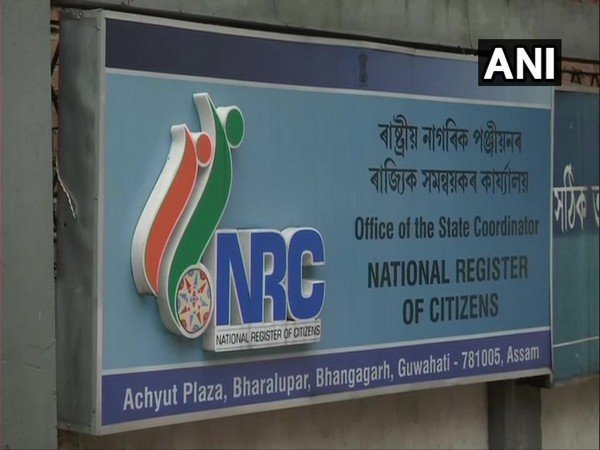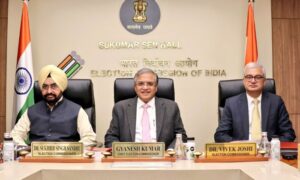
Picture : Twitter / ANI
Open a Pandora’s box literally means” to do something that causes a lot of new problems that you did not expect. ” This is what has happened now with the outcome of the NRC update exercise that has just been made public excluding over 19 lakh people residing in Assam from the Assam specific NRC. A close observer of the entire process that began from the 1985 Assam Accord leaves one with a feeling that the state and federal authorities as well as the Media have ignored and sadly continue to ignore the substantive ” facts in issue” of the matter as listed below which have to be addressed now to take decisions that will stand not only the test of extant laws, but more critically the test of history.
As many as 10 out of 33 districts of Assam were parts of 3 large revenue yielding districts – Goalpara, Sylhet and Cachar which were” transferred” from Bengal in 1874 when the chief Commissioner’s Province of Assam was carved out of the Bengal Presidency to make the new Province financially viable. As per 1901census the Bengali speaking people formed the largest segment-44% and the Assamese 22% of the population of the composite province and the people in Hills Districts and plains spoke a wide range of Tribal and other languages. The Sylhet referendum in 1947 left only Karimganj part of Sylhet in India which is now a District while Cachar and Goalpara remained in India.
Under Lord Curzon’s Partition of Bengal plan Assam became a part of the new Province of Eastern Bengal and Assam; and even after annulment of the Partition in 1912 and restoration of the identity of Assam as a separate province , the three ” transferred” Districts remained in Assam. So there has always been an “East Bengal” in Assam and these are the “Districts bordering Bangladesh now” as Assam proper have no land border with Bangladesh. Thus every person who had his ” domicile” in these Districts at the time of commencement of the Constitution are as much ” original” as people elsewhere in the country and deemed to be citizens of India under Article 5 of the Constitution. Movement of the Hindus seeking refuge in these Districts after Partition violence and even thereafter was much like the movement of the Hindus and Sikhs in divided border Districts like Gurudaspur in Indian Punjab . The short point is that Bengali people in these areas are not ” migrants”; and one must note that India surrendered for strategic reasons Buddhist dominated (over 87%of the population were Buddhist chakma tribals) Chittagong Hill Tracts,an Excluded Area under the Government of India Act 1935 to Pakistan from which Chakmas were driven out by Pakistan in 1960’s by way of ” ethnic cleansing”. The Chakmas sought shelter in North East and have not received citizenship in Arunachal.
Partition didn’t divide the Bengali Hindus only as it divided the Garos,Khasi- Jayantias and Manipuris, Tripura Tribals and Mizos. (The first Hindu Chief Justice of Bangladesh S K Sinha was a Manipuri) . The movement of tribals from Bangladesh to these states in the north east has been well known.
[the_ad id=”17325″]
The historical commitments made to the minorities who sought shelter in India are embedded in the Nehru Liaquat Pact 1950 and the protective provisions under the Immigrants (expulsion from Assam) Act 1950 as the provisio to section 2(b) of the Act states that it would” not apply to those who left Pakistan on account of civil disturbances or fear of such disturbances”. There is thus no question of treating any refugee or displaced person as a ” foreigner” under the Foreigners Act 1946 who could claim and deserve even now protection under this Act.
The mystique of NRC Assam 1951 needs unraveling as if it were a complete exercise covering the whole of Assam which in 1951 included the whole of today’s north east except Tripura and Manipur. The fact is that NRC wasn’t prepared for the Sixth schedule and the hills Districts which now comprise Meghalaya, Mizoram, Nagaland and Arunachal. Second, according to the recent Press reports NRC was not prepared for Cachar including the sixth schedule subdivision of North Cachar Hills. In the 1950 quake devastated District of Dibrugarh , even the census work was badly affected. NRC was essentially a census based documentation carried out only in Assam and not in Bengal for one single reason: it was the ” assessment” that taking advantage of the provision of the Nehru Liaquat Pact signed on April 9, 1950 allowing ” minorities” of both sides of the border to return to their original habitations by December 30 1950, more Muslims did actually migrate to Assam.The Immigrants Act 1950 was enacted to stop this movement of Muslims to Assam followed by the implementation of the Prevention of Infiltration from Pakistan (PIP) scheme of the government of India in 1964 to meet this threat.
These facts are enough to lead a discerning reader to question the veracity of the sentence that occurs with monotonous regularity in PTI reporting on the NRC -” Assam has seen a huge influx from other places particularly Bangladesh since the early 20th century”. This , to put it mildly is a glib statement that betrays a lack of understanding of how parts of Bengal were integral to the province of Assam and how the colonial economy shaped demographics of South Asia. The huge success of jute in East Bengal in the 19th century- “the first green revolution”and its prospects in largely uninhibited low lands of the Brahmaputra valley in lower Assam prompted the colonial government to encourage settlement of farmers from these East Bengal Districts- mostly Muslims and mainly from the neighbouring Mymensing to these areas under what was called the” Line system” restricting their settlement to West and Lower Assam . This period also saw movement of farmers within Assam from “Transferred Districts” to Nowgong and Darrang Districts as jute cultivation spread. This made Assam today the third largest producer of jute in India. In the same period success of Tea in Assam led to migration of Adivasi labor from Chhotanagpur plateau, Orissa and Bengal as the local labor wasn’t there at all for work in Tea plantations under conditions of of what RC Dutt, the great economic historian termed” wage slavery”. And Assam is the largest producer of Tea in the country.
Rural demographics of Assam thus changed much like the way demography of the Malayan peninsula changed with the introduction of Rubber plantations ; and history shows that nothing short of civil war as it took place in pre Partition Punjab could alter substantially the rural demographics anywhere.
The only viable option for a democratic state and society in this situation is to reconcile its identity with demography and economics because once opened” Pandora’s box ” cannot be shut.


















